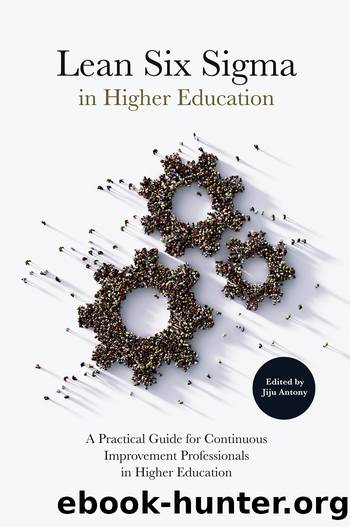Lean Six Sigma in Higher Education by Antony Jiju;

Author:Antony, Jiju;
Language: eng
Format: epub
Publisher: Emerald Publishing Limited
Published: 2019-09-25T00:00:00+00:00
7.3 How Lean Six Sigma Can Support the Grant Application Performance
Six Sigma is a methodology which aims to remove process defects and wastes and improve operational efficiency and performance (Antony, Sony et al., 2019). Having a similar purpose, Lean also seeks to eliminate waste. However, the two methodologies differ in their approach regarding the source of this waste. Six Sigma focuses on process variation, whilst Lean concentrates on flow through value added and non-value added process activities. When Lean and Six Sigma methodologies combine as Lean Six Sigma (LSS), this merging maximises their individual strengths as LSS addresses âthe root cause of the problems related to process flow and waste and reduces variation within a processâ (p. 511) (Antony, Forthun, et al., 2019). LSS strategies underpin continuous improvement (CI) programmes in manufacturing, service and public service organisations (Albliwi, Antony, & Lim, 2015). When LSS for service is implemented successfully, the gains typically include significant increases in customer satisfaction and quality, reduced cost and an alignment of the speed of the associated processes with customer demand (Antony, Douglas, & Douglas, 2015; Li, Ely, & Laux, 2017). LSS provides a set of tools including Value Stream Mapping, Process Mapping, Voice of the Customer, 5S and Trend Charts. These tools support organisations in listening to the âvoice of the customerâ, removing non-value added process steps (i.e. waste), reducing quality cost, decreasing cycle time and delivering product/service at the expected time in the designated location. Within the university context, LSS can be applied to identify, reduce or eliminate waste, thereby increasing process efficiency and effectiveness (Antony, Ghadge, Ashby, & Cudney, 2018). However, in implementing LSS in a tertiary environment, one needs to be more mindful that cultural issues and organisational structures are more complex than those for manufacturing companies and/or service organisations (Lu, Laux, & Antony, 2017).
Challenges and barriers identified within the American university sector include (Li et al., 2017; Raifsnider & Kurt, 2004; Simons, 2013):
Time preparing for accreditation.
Ineffective communication between units and departments thereby resulting in the establishment of silos.
Lack of process transparency in teaching, research, innovation and auxiliary processes.
Insufficient capacity to deal with funding application submissions during peak periods of funding calls.
Ignoring the customer's voice.
Hidden costs.
Lack of simplification and streamlining of document-intensive processes.
Lack of student retention.
Download
This site does not store any files on its server. We only index and link to content provided by other sites. Please contact the content providers to delete copyright contents if any and email us, we'll remove relevant links or contents immediately.
| Agile | Lean |
| Quality Control | Six Sigma |
| Total Quality Management |
Hit Refresh by Satya Nadella(8854)
The Compound Effect by Darren Hardy(8508)
Change Your Questions, Change Your Life by Marilee Adams(7372)
Nudge - Improving Decisions about Health, Wealth, and Happiness by Thaler Sunstein(7242)
The Black Swan by Nassim Nicholas Taleb(6763)
Deep Work by Cal Newport(6563)
Daring Greatly by Brene Brown(6222)
Rich Dad Poor Dad by Robert T. Kiyosaki(6174)
Principles: Life and Work by Ray Dalio(5961)
Man-made Catastrophes and Risk Information Concealment by Dmitry Chernov & Didier Sornette(5646)
Playing to Win_ How Strategy Really Works by A.G. Lafley & Roger L. Martin(5499)
Digital Minimalism by Cal Newport;(5389)
Big Magic: Creative Living Beyond Fear by Elizabeth Gilbert(5351)
The Myth of the Strong Leader by Archie Brown(5237)
The Slight Edge by Jeff Olson(5200)
Discipline Equals Freedom by Jocko Willink(5157)
The Motivation Myth by Jeff Haden(5003)
Stone's Rules by Roger Stone(4857)
The Laws of Human Nature by Robert Greene(4773)
